Samosa is a flaky, crispy, and delicious Indian snack. It is made with a pastry stuffed with spiced potato filling and wrapped to form a perfect pyramid, then deep-fried to golden.
You can find these little fried parcels in cafes, restaurants, even street food stores.
I like samosa as that is my go-to teatime snack at the Mamak shop (Indian-Muslim restaurant) near my previous office with a cup of Malaysian teh tarik.
I am no longer working there now, so I decided to make my own to fulfill my gluttonous desire!
Here is my recipe after a few trials to mimic the taste of the samosa offered at my favorite Indian restaurant, with some changes.
Let me show you how to make samosa right now.
Note: This post may contain affiliate links. Please read my privacy policy for more info. I may receive commissions for purchases made through links in this post. As an Amazon Associate, I earn from qualifying purchases.
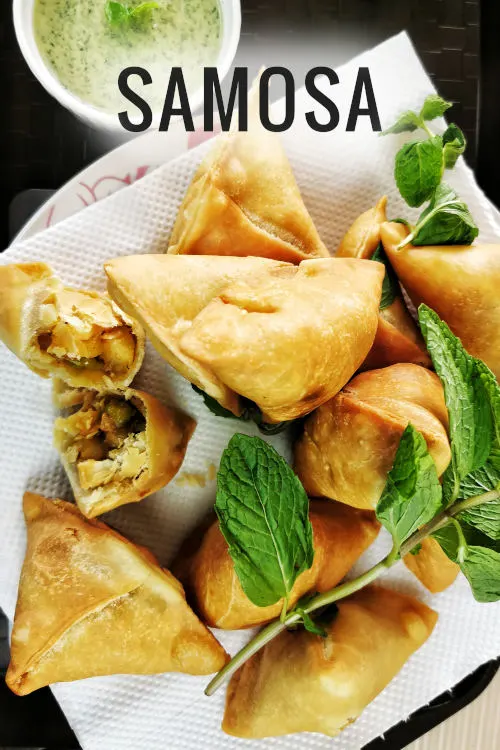
Here is how to make Samosa, step-by-step:
The samosa making is relatively straightforward, except the folding part may take a bit of practice. This recipe is general, not specific to any region, and best suits my taste. I hope you will love it as much as I do.
1. Prepare the spiced potato stuffing
- Potatoes are the essential ingredient for stuffing. I wash, peel, and boil the potatoes until they are soft but not mushy. You can also make keema samosa which includes minced meat.
- My method is to peel the potatoes first, then cut them into half or quarters so that each piece is about the same size. The uniform size of potatoes will cook roughly simultaneously so they will have the same softness when cooked. It takes about twenty minutes to cook the potatoes. After that, cut into small cubes.
- Melt two tablespoons of ghee in a pan over low to medium heat. Then add the minced garlic and ginger and saute for half a minute.
- Add a tablespoon of cumin seeds and continue the process. When the cumin seeds start to splutter, add the chopped green chilies followed by the chopped onions. Pay attention to the cumin seeds so that they will not be overburned and turn bitter.
- Now continue to saute over low to medium heat for three to four minutes until the onion starts to turn soft.
- Season it with several spices. The spices are chili powder, coriander powder, garam masala, salt to season, and lemon juice. You may also add amchur (dried mango) powder, hing, and fennel powder. I omit these items to keep things simple.
- If you have already boiled and cut the potatoes into small pieces, mix the potatoes with the spices. I also added some frozen green peas, but you can omit them.
- Add some water to continue cooking the potatoes. Blend well with the spices until they start to disintegrate and become slightly sticky. Continue cooking until nearly all the water has evaporated. The stuffing will wet the pastry if there is too much water.
- Sprinkle some chopped coriander leaves and mix well. Then remove from heat and let it cool thoroughly before using it in the next step.
2. Make the samosa pastry (the crust)
Making the crust needs a bit of technique. Below is my foolproof explanation.
- Mix the all-purpose flour and salt in a large mixing bowl.
- Next, add the oil of your choice to the flour. It can be ghee, butter, or any vegetable oil with a neutral taste, such as corn oil.
- Rub the oil into the flour gently with your fingertips. The oil will incorporate the flour and eventually form granules that look like breadcrumbs after one minute. This method is quite similar to making the shortcrust pastry.
- If you press down a handful of this mixture with your palm, it should be firm and hold its shape and will not crumble. When this happens, the oil and flour are incorporated well.
- Now add the water to the ‘breadcrumbs.’ Do not overwork the dough as it will become less flaky. This step is crucial for making a flaky samosa pastry.
- The amount of water is crucial to the success of making excellent samosas. If you use too much water, the pastry will become too soft to handle while wrapping the stuffing and will be unable to stand on its own and may become out of shape. It will also become less crispy due to the higher water content and developing plenty of blisters on the surface while deep-frying.
- On the contrary, if there is too little water, the pastry will become crumbly and crack while rolling it out to form an oval shape. It will also tend to burst at the seam while deep-frying as it is too dry to seal the folding securely.
- The guideline of how much water is required is to add sufficient water to make it roll out without cracking and become crumbly. I use 70ml of cold water for 250g of all-purpose flour to yield the best result. The amount of water you need might slightly vary as the quality of the flour and the humidity of where you live may not be the same as mine.
- Continue kneading the dough until it becomes firm, stiff, and non-sticky.
- Then roll it to form a ball and apply some oil on the surface to prevent drying.
- Finally, cover the dough with a damp cloth and let it relax for at least thirty minutes before continuing to the next step.
- After the dough has relaxed for more than thirty minutes, divide it to become six equal portions. Knead each portion for another one minute, then roll it to form individual balls and let it rest for another ten minutes.
- The dough is now ready to use as the pastry to wrap the stuffing.
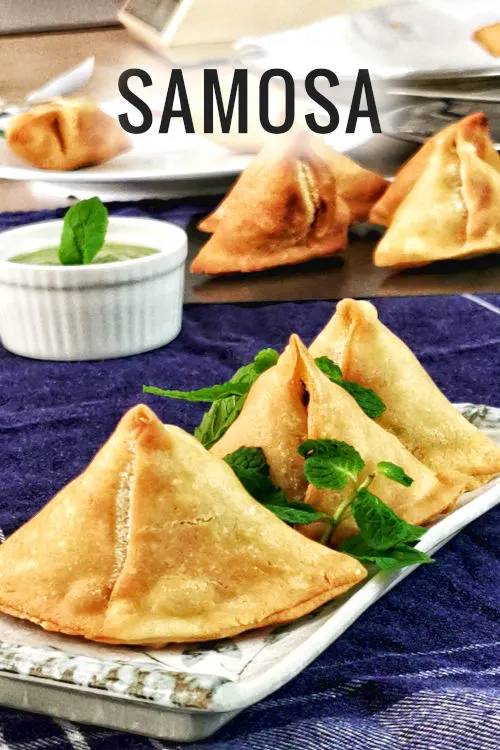
3. Wrap the stuffing with the pastry
The wrapping of stuffing might take a bit of practice to get it perfect. However, since there are different ways to wrap the stuffing, I use a simple method that I think is easiest.
- Place one portion of the dough on the pastry mat.
- Apply a small amount of oil on the surface. The oil helps to prevent it from sticking to the rolling pin.
- Roll out the pastry twith a rolling pin o become an oval, about 8”x6”. The dough will tend to retract back after rolling out as it is quite a dry dough. However, you can roll it out once and set it aside to let it relax for a few minutes, then roll it again in the event it is too hard to form a thin sheet.
- Cut the dough crosswise into two with a dough cutter. Each part will make one samosa.
- You may need to roll each of them once more if the edges are too thick, as it is normal for the pastry to shrink back.
- Apply some water to the straight edge.
- Fold both corners of the straight edge invert with the center of the straight edge as the pivotal point. Join corners together and overlap slightly. It now looks like a cone.
- Press the join firmly by pressing it from inside the cone, and pinch the tip of the cone to close it completely.
- Hold the cone with your thumb and index finger. Place the potato stuffing into the cone, and press it lightly to fill up the tip of the cone. Add the stuffing until it fills the cone and leaves about one cm clear from the circumference of the cone.
- Apply some water to the circumference.
- Crimp the pastry at the opposite side of the joint to make a pleat, then press and seal it up.
- Pinch and press the sealing area well to prevent the samosa from bursting during deep-frying. Trim off the excess pastry if necessary.
- Now you have a perfect standing samosa!
4. Deep-fry
The success of making the samosa also depends on the temperature of the oil. If the oil is too hot initially, the outer layer of the dough will cook and form the crust quickly, causing the samosa to be unable to expand fully. It also makes the outer layer turn brown too fast, while the inner part of the pastry is still not fully cooked.
If the temperature is too low, the pastry will become oily.
- Heat the vegetable oil in a pan at 130°C/265°F. You can use any vegetable soil with neutral flavor such as sunflower oil, canola oil, etc.
- The depth of the oil must be sufficient to submerge the samosa fully when it is lying on its side. (not standing). If you do not have a kitchen thermometer, the temperature is right when tiny bubbles rise from the samosa. Reduce the heat if there is a large sizzling sound.
- Drop the samosas into the oil in the standing position. Do not disturb the samosas during the first minute as they are still too soft.
- After the first minute, stir the samosas around gently.
- Deep-fry the samosa at 130°C/265°F for four minutes or until they start to float to the top. At this stage, they will no longer be able to stand but fall to their sides.
- Increase the heat to 180°C/350°F and continue to deep-fry until golden.
- Remove the samosa and drain on a paper towel.
Note: If you deep-fry the samosas in batches, please wait for the oil to cool before deep-frying again.
Common problems (and solutions) of making samosa
1. The samosa is not crispy
If you add too much water to make the pastry, the higher water content of the dough will make it less crispy. Instead, use just enough water to form a firm pastry.
2. The surface of the samosa has many blisters
Two factors contribute to the blisters- too much water in the dough and high initial frying temperature. You need just enough water to form a firm dough yet not crumbly. Also, be patient during deep-frying by starting with a low temperature.
3. The samosa is hard
The most likely reason is there is insufficient oil in the pastry.
Common questions about making samosa
1. Can I use other oil instead of ghee?
You can use ghee, butter, or other vegetable oil with a neutral flavor to make samosa.
2. Can I bake instead of deep-frying samosa?
You can bake it at 175°C/345°F for about 40 minutes. Apply some oil on the surface before baking the samosa. However, deep-frying samosa tastes much better.
3. Is it possible to simplify the dough-making process using store-bought spring roll sheets?
You can use spring roll sheets to make the samosa, but the taste and texture are different.
4. Can I substitute all-purpose flour with whole wheat flour?
You can use whole wheat flour, but it does not taste as good as all-purpose flour. Therefore, I suggest only replacing half of the all-purpose flour with whole wheat flour.
5. Can I freeze the samosa?
Once you have stuffed and shaped the samosa, place them in a freezer-safe container. Samosa should be eaten fresh, so it is not advisable to freeze them after deep-frying.
If you like this samosa, check out the Malaysian curry puff recipe, which closely resembles samosa. The main difference is the pastry is more flaky and layered. You can get the recipe here.
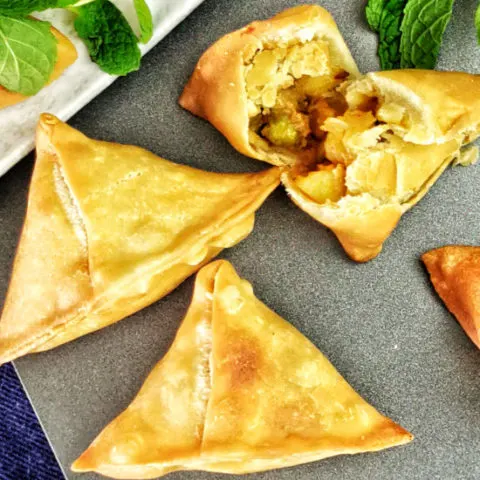
How to make samosa, the perfect Indian style snack
Samosa is a flaky, crispy, and delicious Indian snack. It is made with a pastry stuffed with spiced potato filling and wrapped to form a perfect pyramid, then deep-fried to golden.
Here is my recipe after a few trials to mimic the taste of the samosa offered at my favorite Indian restaurant, with some changes.
Ingredients
For the stuffing
- 2 tbsp ghee
- 2 tbsp minced garlic
- 2 tbsp minced ginger
- 1 tbsp cumin seeds
- 2 tbsp chopped green chili
- 1 medium-sized onion, diced
- 1 tsp chili powder
- 1 tsp coriander powder
- 1/2 tsp garam masala
- 1/2 tsp salt
- 1 tbsp lemon juice
- 400g potato, boiled and diced
- 150g frozen green peas
- 1/4 cup water
- 1/2 cup coriander leaves, chopped
For the pastry
- 250g all-purpose flour
- 1 tsp salt
- 60g ghee
- 70ml water
Instructions
Prepare the spiced potato stuffing
- Wash, peel, and boil the potatoes until they are soft but not mushy about twenty minutes. After that, cut into small cubes.
- Melt two tablespoons of ghee in a pan over low to medium heat. Then add the minced garlic and ginger and saute for half a minute.
- Add a tablespoon of cumin seeds. When the cumin seeds start to splutter, add the chopped green chilies, chopped onions. Saute until the onion begins to turn soft.
- Season it with chili powder, coriander powder, garam masala, salt, and lemon juice. Finally, add the potatoes and frozen green peas.
- Add some water to continue cooking the potatoes.
- Sprinkle some chopped coriander leaves and mix well. Then remove from heat.
Make the samosa pastry (the crust)
- Mix the all-purpose flour and salt in a large mixing bowl.
- Next, add the oil of your choice to the flour.
- Rub the oil into the flour until it looks like breadcrumbs.
- Now add the water.
- Continue kneading the dough until it becomes firm, stiff, and non-sticky.
- Then roll it to form a ball.
- Finally, cover the dough with a damp cloth and let it relax for at least thirty minutes.
- Divide it to become six equal portions. Knead each portion for another one minute, then roll it to form individual balls and let it rest for another ten minutes.
Wrap the samosa stuffing with the pastry
- Place one portion of the dough on the pastry mat.
- Apply a small amount of oil on the surface. Roll out the pastry to become an oval, about 8”x6”.
- Cut the dough crosswise into two.
- Apply some water to the straight edge. Fold both corners of the straight edge invert with the center of the straight edge as the pivotal point. Join corners together and overlap slightly.
- Press the join firmly by pressing it from inside the cone, and pinch the tip of the cone to close it completely.
- Place the potato stuffing into the cone.
- Leaves about one cm clear from the circumference of the cone.
- Apply some water to the circumference.
- Crimp the pastry at the opposite side of the joint to make a pleat, then press and seal it up.4. Deep-fry the samosa
Deep-fry the samosa
- Heat the vegetable oil in a pan at 130°C/265°F.
- Drop the samosas into the oil in the standing position. Do not disturb the samosas during the first minute.
- After the first minute, stir the samosas around gently.
- When they start to float to the top, increase the heat to 180°C/350°F and continue to deep-fry until golden.
- Remove the samosa and drain on a paper towel.
Recommended Products
As an Amazon Associate and member of other affiliate programs, I earn from qualifying purchases.
-
 Rolling Pin & Silicon Pastry Mat,Silicone Large Pastry Mat With 19.6" x 15.7",Dough Roller Sleek and Sturdy 11.8" Perfect Match
Rolling Pin & Silicon Pastry Mat,Silicone Large Pastry Mat With 19.6" x 15.7",Dough Roller Sleek and Sturdy 11.8" Perfect Match -
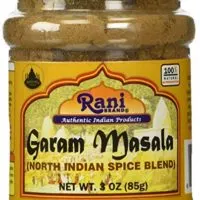 Rani Garam Masala Indian 11 Spice Blend 3oz (85g) Salt Free ~ All Natural | Vegan | Gluten Free Ingredients | NON-GMO
Rani Garam Masala Indian 11 Spice Blend 3oz (85g) Salt Free ~ All Natural | Vegan | Gluten Free Ingredients | NON-GMO -
 Original Grass-Fed Ghee by 4th & Heart, 16 Ounce, Keto, Pasture Raised, Non-GMO, Lactose Free, Certified Paleo
Original Grass-Fed Ghee by 4th & Heart, 16 Ounce, Keto, Pasture Raised, Non-GMO, Lactose Free, Certified Paleo -
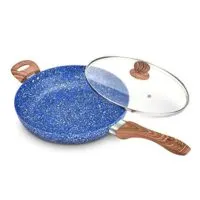 MICHELANGELO 12 Inch Granite Frying Pan Nonstick, Ultra Nonstick Frying Pans with Non toxic Stone Coating, Nonstick Skillet with Lid, Granite Rock Pan 12 Inch, Ceramic Induction Skillet - Blue
MICHELANGELO 12 Inch Granite Frying Pan Nonstick, Ultra Nonstick Frying Pans with Non toxic Stone Coating, Nonstick Skillet with Lid, Granite Rock Pan 12 Inch, Ceramic Induction Skillet - Blue
Nutrition Information:
Yield: 12 Serving Size: 1Amount Per Serving: Calories: 188Total Fat: 8gSaturated Fat: 4gTrans Fat: 0gUnsaturated Fat: 3gCholesterol: 18mgSodium: 302mgCarbohydrates: 27gFiber: 2gSugar: 2gProtein: 4g
This data was provided and calculated by Nutritionix on 12/3/2021

Janet Lumangaya
Friday 3rd of December 2021
Hi KP Kwan, Thank you for sharing this recipe. I have been wanting make samosas too as they are my favorite teatime snack with masala tea, I have tried a few of your other recipes and they were very good, especially the Chicken Biriyani. For this samosa recipe it would be good if you could make a short video on the pastry making, rolling, cutting, folding. Thank you, By the way I have not seen a recipe for Curry Laksa on your website, unless its posted recently. That is one of my all time favorite foods and I think it's originally Malaysian? If you can share that would be great as well! Keep the great recipes coming, Thank you
KP Kwan
Saturday 4th of December 2021
Hi Janet, Thank you for your comment. A video embedded in the article (somewhere in the middle) shows the whole process. If you can't find it, you can view it on my youtube channel. Here is the link to youtube: https://youtu.be/XRD1RzSm-9o I wish you all the best in making samosa. There is no curry laksa recipe so far on this food blog, but I will keep that in mind for the development of the new recipes in the future :) KP Kwan
Peck
Friday 3rd of December 2021
Hi, Can use the wonton skin for this farm's recipe instead?
KP Kwan
Saturday 4th of December 2021
I would suggest using spring roll skin, which yields a better result.
KP Kwan
Friday 3rd of December 2021
Hi, this is KP Kwan. I am happy to see you in this comment area, as you have read through my recipe. I am glad to reply to any questions and comments as soon as possible.